Feather Core®: Lightweight Blockboard
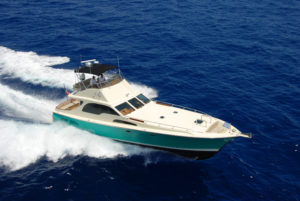
Feather Core® is a finger jointed blockboard panel specifically designed to be light, rigid, and highly stable. It is a lightweight plywood solution for a wide variety of applications from boat building to office furniture to RVs and the aerospace industries. This product was originally developed with the boat builder in mind, and it was quickly discovered that it could be also used effectively in many other applications where stiffness and a lighter weight are desired features.
How LIghtweight is feather core?
- Weight of 12.2 mm panel is 28 lbs
- Weight of the 18.5 mm panel is 42 lbs
The key was in choosing a lumber core which is typically made from softwoods. More durability was needed and screw holding power is important, so a hardwood, low density species (Falcata) was chosen instead. To further reduce the weight and add stability, a Falcata cross banding veneer is added to both faces. Finally, an A face Marine Meranti front veneer is added with the option for an A or C grade back veneer. This different facing option gives you some options when only 1 good face is needed in your application, while providing a bit of cost savings over the good 2 face panel option.
Feather Core® is available in both 12.2mm and 18.5 mm thicknesses and 48 x 98 (1220mm x 2500 mm) sheets.
Get the Feather Core Product Flyer
Feather Core® specifications
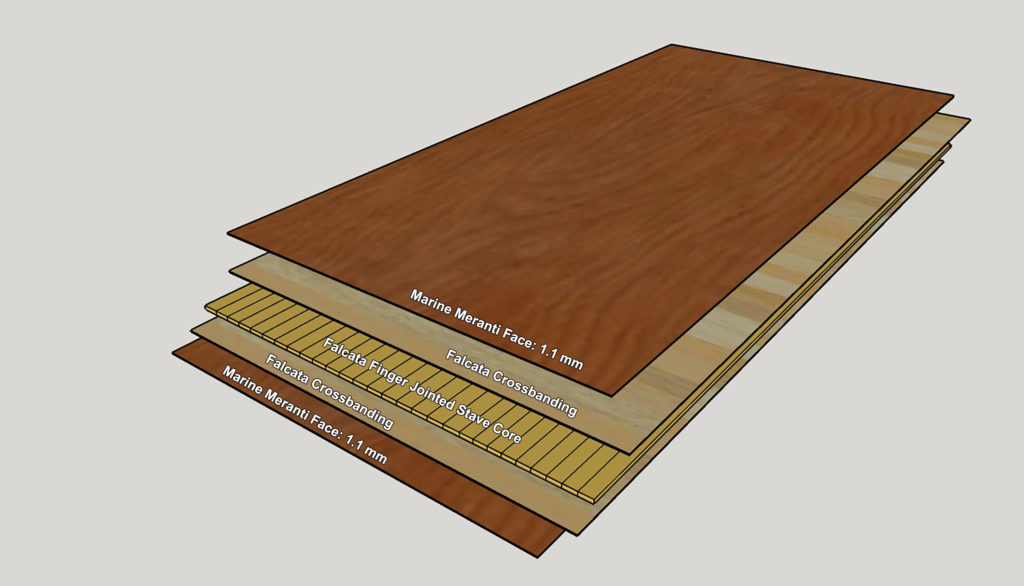
| Size | 12.2 x 1220 x 2500 mm | 18.5 x 1220 x 2500 mm |
| Face/Back Veneer | Marine Meranti .75 mm | Marine Meranti 1.1 mm |
| Cross Band Veneer | Falcata 1.5 mm | Falcata 2.6 mm |
| Core | Falcata 7.8 mm | Falcata 11.4 mm |
| Weight | 28 lbs | 42 lbs |
| Glue Type | E1 class T2FE0.3 | |
| Formaldehyde Emission | 0.1 mg/L | 0.3 mg/L |
| Density min/max | 19.8/21.7 lb/ft3 | 19.8/21.6 lb/ft3 |
| Hardness min/max | 938/1536 lb/in2 | 1095/1493 lb/in2 |
| Screw Holding min/max (BS EN 320) | 130/216 lbf | 137/212 lbf |
| Bending Test | 12.2 mm | 18.5 mm | ||
|---|---|---|---|---|
| BS EN Method (BS EN 314) | parallel to face | perpendicular to face | parallel to face | perpendicular to face |
| MOE Ave (psi) | 764,869 | 384,902 | 541,702 | 356,895 |
| Class | E50 | E25 | E35 | E25 |
| MOR Ave (psi) | 6,309 | 3,185 | 4,977 | 2,864 |
| Class | F25 | F10 | F20 | F10 |
What is Blockboard?
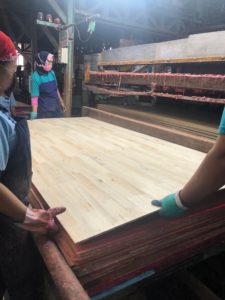
Blockboard is like traditional veneer core plywood in that it has a core and thinner face veneers. However, it uses thicker, solid wood pieces for the core. These narrow pieces called “staves” or “battens” are glued up side by side to make a wider panel, and then the face veneers are glued to the front and back. The staves usually are around 2″ wide but will vary from panel to panel. The thickness of the staves depends on the overall panel thickness, but it is generally about 2/3 the total panel thickness. It is this element that distinguishes a blockboard panel, as its core is essentially narrow blocks of solid lumber rather than thin veneers. In fact this construction method is also commonly called lumber core plywood (especially in the US) or even stave core plywood. The cores can be constructed a number of ways for a number of reasons, but primarily using thicker solid wood makes for a much more rigid panel that won’t sag over long lengths and will hold fasteners strongly just like regular lumber.
Over the years these engineered core materials have come under fire with more voids and splits between the staves in the core, making lumber core plywood fall out of favor. We wanted to reengineer this core construction model but apply higher grade standards in order to create a well performing panel which our high end boat builder and furniture customers could use without incident. Working closely with a reputable plywood manufacturer, we established a grade that would not allow any voids or splits in between the staves, and we then further locked the piece together using finger joints at the ends of each piece. Additionally, we ensure the finger joints do not line up in adjacent staves, and by minimizing this we are able to create an even more rigid panel throughout.
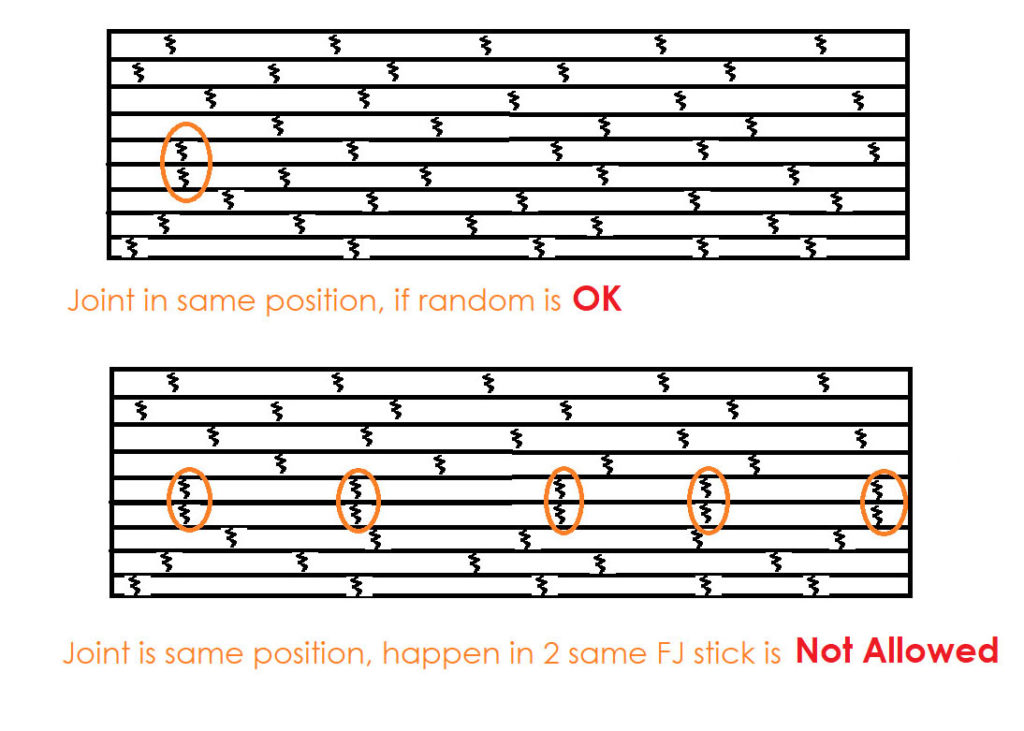
Lightweight Plywood Without Sacrificing Stability Or Strength
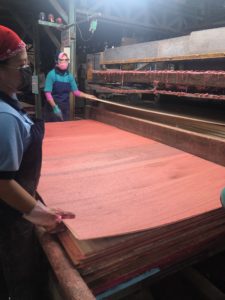
Feather Core® first and foremost was developed to be a stable panel that would be light weight. We knew that we could maintain rigidity by using a lumber core plywood construction, but choosing the right species of wood would be essential to control the weight and still maintain strength. Most lumber core uses a softwood species, but we wanted some extra strength and screw holding power, and so we chose a hardwood in the form of Falcata. (more on that below)
Furthermore, most blockboard panels use the same species for the face veneer as well as the cross banding. In this case we are using a Marine Meranti face, but that added significant weight with little advantage in controlling strength or the telegraphing of the individual staves to the face. It made the most sense to use the same low density Falcata for the veneer cross banding to reduce weight and still serve the same function.
Paraserianthes falcataria
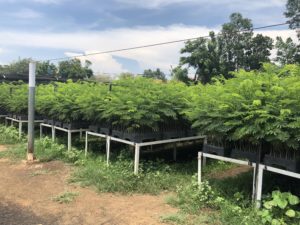
Across its wide geographic range, Falcata is primarily grown as a species with a very low density. Interestingly, it is a wood that you already are very familiar with. You probably already have it in your home because matchstick and chopsticks are made from it. The key here for us is it is an established species with a strong harvest so, silviculturally speaking, many of the kinks in the supply chain have been figured out.
Across its geographic range are many Falcata plantations and nurseries and a network of villages cultivating the trees for local sawmills to process into lumber. This network employs a great many people with a lot of redundancy built in to account for spikes in demand for the product. Finally, all the sawmills and production facilities had already been vetted by third party auditors and were fully compliant with legal timber production. All of this was a major deciding point for us in choosing Falcata as the species of choice for Feather Core.
Lumber Core Plywood is Stiffer than Traditional Plywood
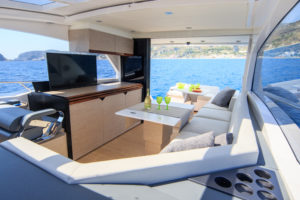
The easiest way to describe this to to take two pieces of wood of any species. One of them is 1/4″ thick and the other 1″ thick. Bend each piece and obviously the 1/4″ bends easily while the 1″ may not bend at all. This is the same principle with lumber core plywood. Veneer core plywood will sag when longer lengths are used and especially when spanning distances under load. This is where a lumber core construction shines and was originally created for piano manufacturers that needed that span in a grand piano. Furniture companies continue to use it for bookcases and office furniture – like desks – with wide span requirements.
In short, the lumber core panel has an incredibly long history that has allowed us to identify strengths and shortcomings in a variety of applications. Feather Core plays with the variables of core construction, species, and veneers to ameliorate some of the shortcomings and produce an exceptionally lightweight, rigid and stable plywood panel.


